Sometimes it can feel like you’re playing a game in slow motion when your FPS suddenly drops. This is especially true if you are used to playing smoothly at higher frame rates. So what causes your FPS to drop suddenly, and how can you fix it?
Your FPS will suddenly drop if your graphics card isn’t powerful enough or you are overworking your computer. To fix this, open the Task Manager (Ctrl+Shift+Esc) and terminate the most active processes. You can also visit the manufacturer’s website and update the graphic card drivers.
Several other ways to improve your FPS include tweaking the game settings and restarting your computer. We tell you all about this, the reasons behind an FPS drop, and so much more. So let’s get right into it.
What is FPS?

Before we look at the causes of FPS drops and how to fix them, let’s ensure you understand what FPS means. FPS stands for Frames Per Second, the rate at which your system renders a video game.
The higher the frame rate, the smoother the motion in-game. Generally, 30 FPS is considered the minimum acceptable rate for normal gameplay. However, 60 FPS is preferable in most cases and provides an even smoother experience.
More advanced systems, such as the Xbox Series S (on Amazon), can handle higher rates like 100 or 120 FPS. However, anything above this isn’t necessary for most games and can strain your CPU.
FPS is important because it dictates how smooth your gameplay is. Low FPS can make games look choppy and difficult to control, while high FPS provides a much more immersive experience, not to mention a competitive edge.
What Causes FPS to Drop in a Video Game?
There are a few potential causes of sudden FPS drops. Here are the most common ones.
- Graphics Card: The most common reason for an FPS drop is that your graphics card isn’t powerful enough. The graphic settings are creating a larger workload than your hardware can handle. This means that it can’t render the game quickly enough to keep up with the demands of the game.
- Running Processes: Your computer might also be running too many processes simultaneously. This can cause it to slow down overall, including the performance of your game.
- Improper CPU: Your CPU isn’t up to the task. If your system is underpowered, it won’t be able to keep up with the demands of the game. The RAM and CPU might not be able to handle the load.
- Overheating: If your hardware is overheating, then it won’t be able to run as efficiently and will start to suffer from performance drops. Clear any dust or other debris blocking the cooling vents.
- Problems Connecting: Lastly, you might suffer from sudden FPS drops if there are connection issues. Typically, this depends on the type of game you’re playing and how it’s designed. For example, if you’re playing an online shooter and your connection is unreliable, it can result in FPS drops.
How to Fix Your FPS?
Now that you understand what causes FPS drops, there are a few troubleshooting tips you can use to try and fix the problem.
Make Sure Your Monitor Meets the Video Game Requirements
Before anything, ensure your monitor meets the requirements of the video game. Check the game’s system requirements, and make sure your monitor is up to par. If it’s not, you won’t be able to play the game at a consistent frame rate.
Each game has a minimum, recommended, and even optimal settings. The higher the resolution of your monitor, the more demanding the game will be for your system.
You can lower the game’s settings to make it more manageable for your hardware. For example, turn down the resolution, shadows, and anything else that isn’t absolutely necessary.
Check Internet Connection
If your frame rate suddenly drops and no other changes have been made, it’s likely because of a weak or slow internet connection. Check your connection’s status to ensure it’s running smoothly and that no other devices are using bandwidth.
If you’re having trouble, try restarting your router or switching to a new connection provider. You could also try changing the DNS server you are using, as it can sometimes cause FPS drops due to slow response times.
If all else fails, you may need to upgrade your internet plan or invest in a better router. Faster speeds will help reduce lag and increase your frame rate.
Turn off Unnecessary Background Processes and Applications
As mentioned earlier, one of the causes of sudden FPS drops is overheating. An excellent way to fix this is to turn off any unnecessary background processes and applications that may be using your system’s resources.
This will help reduce the strain on your hardware and, in turn, improve the FPS. Here’s how to stop any unnecessary applications and processes on your computer:
- First, open the Task Manager (Ctrl+Shift+Esc) and select the Processes tab.
- Next, select each process or application you don’t need and terminate them by pressing the End Task button. After you’ve done this, check if your FPS has improved.
- If it hasn’t improved significantly, try turning off more applications and processes until you find the one causing the drop. Once you’ve identified it, uninstall or reconfigure the program to prevent it from running in the background.
You can also turn off your computer and give it a few minutes to cool down before turning it back on and playing the game again. This should help reduce the strain on your hardware and improve FPS levels.
Update Your Graphics Card Drivers

If your system can’t handle the game at its highest settings, you may need to update your graphics card drivers. Updating your graphics card drivers can help improve performance and stability by fixing bugs or compatibility issues.
Go to the manufacturer’s website and download the latest version of the driver. Install it and then restart your computer for the changes to take effect. You should notice a performance improvement.
Check for Malware and Viruses
Malware and viruses can cause serious performance issues, so checking for malicious software slowing down your system is vital. Use an antivirus program or, better yet, the system file checker to scan your system and remove any potential threats.
To run the system file checker:
- Go to the Start menu and type cmd. This will open up a command prompt window.
- Then type in sfc/scannow and hit enter. Your computer will scan the system for any corrupted or missing files.
- Once the scan is complete, restart your computer and check if your FPS has gone up.
Defragment Your HDD
Fragmented hard drives can cause serious performance issues, and it becomes imperative to defragment them regularly. Here’s how you defragment your HDD.
- Press the Windows key+E to open File Explorer.
- Right-click on your hard drive and select Properties.
- Go to the Tools tab, and then select the Optimize button.
- In the Optimize Drives window, select your hard drive and hit Optimize.
Defragging your HDD should improve performance and help you get back to enjoying your game with better frame rates.
Turn Off Intel Turbo Boost Technology
Intel Turbo Boost Technology is a feature that helps boost the performance of your CPU. However, in some cases, it can cause sudden FPS drops due to high CPU usage.
If you have an Intel processor, you can turn off the Turbo Boost Technology and see if this helps improve your FPS. Here’s how to disable this feature.
- Press the Windows key+S and type Control Panel.
- Next, go to Hardware and Sounds and select Power Options.
- Next, click Change plan settings and then select Change Advanced Power Settings.
- Scroll down to Processor Power Management and expand it.
- Set the values of Plugged In and Battery to 99% to turn off intel turbo boost technology
- Click Apply to save the changes.
Re-Install the Game
This may seem drastic, but sometimes it’s the only way to eliminate any bugs or corrupted files causing the FPS drops. Re-installing the game should eliminate any performance issues and help you enjoy it again.
You may lose your saved files, so back them up before you begin. Here’s how to do it:
- Go to Start and select Settings.
- Select an App and then click on Manage App.
- Locate the game you want to re-install, select it, and then hit Uninstall.
- Once the game is completely uninstalled, restart your computer and download a fresh copy.
- Install it, and then check if your FPS has improved.
Upgrade to a Better Computer

And when nothing else works, you may need to invest in a better computer. If your current system can’t handle the game at its highest settings, then it’s time to upgrade.
Make sure you look at the game’s hardware requirements and get a computer that can meet or exceed those specs. This will ensure you get the best performance out of your game and prevent future FPS drops.
There are lots of incredible computers out there specifically for gaming. The Acer Predator Orion Gaming Desktop is one such. It may cost you an arm and a leg, but the performance will be worth it.
Back to Normalcy
One of the greatest joys of gaming is the smooth performance. Unfortunately, when your FPS suddenly drops, it can damper the fun and make the game unplayable. Thankfully, with these solutions, you can get your FPS back to normal and continue enjoying the game. Good luck!
